Personal Report of
ETRIA TFC 2016 |
|
| G. Applications to Soft & Non-technical Areas (7 Papers) | |
| Toru Nakagawa (Osaka Gakuin Univ., Japan), Jun. 18; Jul. 16, 2017 (in English) |
|
| Posted on Jun. 21, 2017; Updated: Jul. 18, 2017 |
|
For going to Japanese pages, press buttons.
Editor's Note (Toru Nakagawa, Jun. 18, 2017)
This is a part of my 'Personal Report of ETRIA TFC 2016', whose parent page
was posted on Feb. 14, 2017. The Section (5) Introductions to Papers is going to be posted in 7 HTML pages, categorized with their topics for easier access.
A. Methodology of TRIZ
(Mar. 30, 2017)
B. Integral Use of TRIZ with Relevant Methods(Mar. 30, 2017)
C. Case Studies in Industries(Apr. 24, 2017)
D. Promotion of TRIZ in Industries(Jun. 4. 2017)
E. Usage of TRIZ in Education and in Academia(Jun. 4, 2017)
F. Patent Studies(Jun. 21, 2017)
G. Applications to Soft & Non-technical Areas(the present page) (7 papers) (Jun. 21; Jul. 18, 2017)
Note: This Category G contains 8 papers. I am now posting 2 papers of them. It will take some more time for the introductions of the rest 6 papers to appear here. (Jun. 18, 2017)
Note (TN, Jul. 18, 2017): Since I learned that a paper included in the Proceedings was not presented in the Conference, the paper has been excluded from this page, resulting 7 papers in this category. This page concludes the Introduction of all the individual papers presented at the ETRIA TFC2016 Conference.
Editor's Note (Toru Nakagawa, Jun. 18, 2017) All the figures are shown here from the Authors' slides under the Authors' permissions.
G. Applications to Soft & Non-technical Areas
G1. Opportunities for integrating TRIZ and systematic innovation tools into large scale Agile software development
Teemu Toivonen (Nitor Delta, Finland) ![]()
This is an excellent paper trying to integrate TRIZ and Systematic Innovation (SI) methods into the leading-edge issue of the software development, i.e., large-scale & agile software development. Here is the Abstract by the Author:
Many organizations (private and public) are scaling their software development in order to achieve the required speed and scope to digitalize their current business and utilize opportunities for creating new digital business. Effective and efficient scaling of software development is not an easy problem, although several approaches have emerged in order to solve this problem. Some of these methodologies have experienced reasonable success, one in particular simply known as Scaled Agile Framework (SAFe) is one of the more popular.
SAFe is a holistic framework for Agile software development. The version 3.0 of the SAFe delivers guidance on how to organize and run software development across three layers: 1) portfolio level; 2) program level; 3) team level. The framework gives guidance in terms of principles, roles, deliverables and concrete ways of working. Version 4.0 also adds an optional value stream layer.
The article will cover all layers in terms of their key activities (functions) and highlight key problems using real world examples. Integrating TRIZ/SI tools to the SAFe framework will be addressed from four different perspectives: 1) opportunities to use TRIZ/SI tools to create a focus on more breakthrough innovations as opposed to incremental innovation; 2) addressing key problems in existing SAFe practices with TRIZ/SI tools; 3) using TRIZ/SI tools to enhance the existing SAFe approach; 4) easy to approach examples of using TRIZ/SI tools from real world scenarios.
In order to understand this paper, we need to understand the recent progress in the methodologies of software development. The Author briefly reviews 3 stages, i,e., (a) Waterfall development model, (b) Agile software development, and (c) Large-scale agile software development.
(a) The orthodox model established around 1970s and 80s for mainframe computers and enterprise software was 'Waterfall development model'. Developing reliable software was huge-scale and very heavy tasks involving hundreds or thousands of system engineers and spending a few years. For building the big software consistent and high-performance, it was necessary to set up the requirements first and then go step by step to design, implementation, verification, etc. as shown in the slide (below). Completing each step by writing detailed documents or codes are required because different (types of) experts are involved at subsequent steps.
The software requirements must be worked out at the beginning and fixed during the development period. The software was usually coded in procedural programming languages resulting in tight connection of logics in different features. One of the most serious drawbacks is the fact that the customers who requested the software can see the product only after finishing the whole development work. Updating and enhancing the requirements, due to extension of business and changes in environment, etc., within and after the development cost a lot of work in the form of maintenance.
(b) In parallel to the explosive use of personal computers and internet in 1990s and later, the demands of software development have changed much. User companies and individual users wanted to use handy and efficient software for businesses and office work, etc. Increasingly rapid evolution of technical/social environment urge quick and adaptable development of software. Thus various informal ways (from the orthodox viewpoints) of software development were tried, where quickly made intermediate software are demonstrated to the customers/users for their reviews and are revised and expanded further repetitively. Such ways of software development were made possible by the progress of working environment with personal computers and of the object-oriented programming.
In 2001 pioneering leaders of such new style of software development made the 'Manifesto of the Agile Software Development' (see slide (below left)). 'Agile' means 'able to move quickly and easily'. It was a declaration of drastic changes in the value recognition in the software development. In the top line the Manifesto says 'Individuals and interactions over Processes and Tools', and the footnote explains that "while there is value in the items on the right, we value the items on the left more".
The Author illustrates two figures (in the slide (below right)) as the characteristic features in the Agile Software development. 'Scrum' (as in rugby) means the cooperative formation of the software development team. Various roles of people who requires software (just like customers/users), who manages the team, who designs the architecture, who makes the programs, who tests it, etc. work together in close collaboration and in parallel (i.e., without clear separation of stages like the Waterfall Model).
The second figure schematically shows the development process. 'Backlog' means '(a list of) items to do'. At the initial stage of the project, various features and aspects of the whole software product are considered to break them down as Product Backlog. Then the project team work by the repetition of 'Sprint', i.e., a fixed length of time (say 30 days) for building some parts/features of software which are to be demonstrated and handed to the users at the end of the term. The items to work in the Sprint are decided at the start of each Sprint (from the Product Backlog left at the time). The Team has a short meeting everyday to communicate what's done yesterday, what's to be done today, and what are the current problems, etc. At the end of each Sprint, the software containing the newly built features/parts is to be demonstrated in/out of the project and to be handed to the users. For this purpose, the software need to be tested often (with the assistance of automatic testing). The repetition of Sprint is effective to get feedbacks from the users (and within the project) and to make the software development adaptable to the changes in the environment.
*** Of course this description is a methodological vision; in practice we need various human/technical skills/culture for the success in the Agile Software Development.
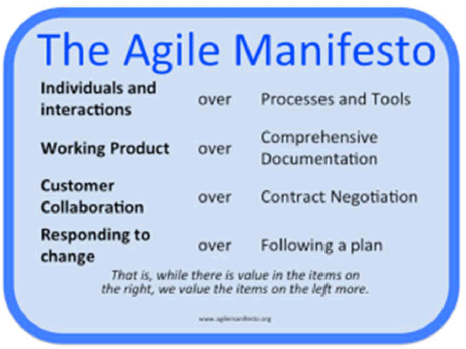
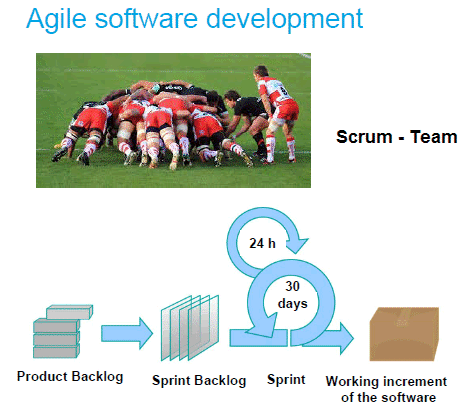
(c) The current issue in the software development methodology is how to apply the Agile ways to the development of larger scale software, such as the ones involving hundreds of engineers. One of such an approach is called 'Scaled Agile Framework (SAFe)', proposed and extended by Scaled Agile, Inc. and its partners. Nitor Delta, for which the present Author is working as a Senior Lean Consultant, seems to be involved actively in SAFe as one of its Golden Partners.
The Author introduces SAFe in the paper as:
"The SAFe framework is a comprehensive knowledge base for doing large scale agile software development. It gives guidance for team level (how should Agile teams work), program level (how should planning, coordination and integration be done across teams) and portfolio level (selection and analyses of initiatives, setting high level goals, linking strategy to development work, and program level funding decisions).
Version 1.0 was published in 2011. It is based on extensive experiences gathered from many companies and sources."See the slide (below).
The overall structure of SAFe (in its current version 4.0) is illustrated in the figure (below).
[Note: The Author uses the nice SAFe framework figure downloaded from the public SAFe Web site at URL: http://www.scaledagileframework.com/
. As the Author mentions in his Abstract, SAFe 4.0 has introduced an optional level between Portfolio Level and Program Level (for even larger scale development). The Author shows the 4-level scheme in his slide, but explains only 3 levels of them. So I choose to show the 3-level scheme in the figure (below). For a clearer image in the PDF format, click this button
.
The SAFe Web site publishes full documents about the SAFe methodology and its case studies. Its White Paper
: "SAFe® 4.0 Introduction: Overview of the Scaled Agile Framework® for Lean Software and Systems Engineering" by Dean Leffingwell (Scaled Agile, Inc.) (July 2016) is an excellent reference. In the overall view figure, there are various terms of specific use; Clicking the keywords in the SAFe top page will guide you to detailed descriptions of them.]
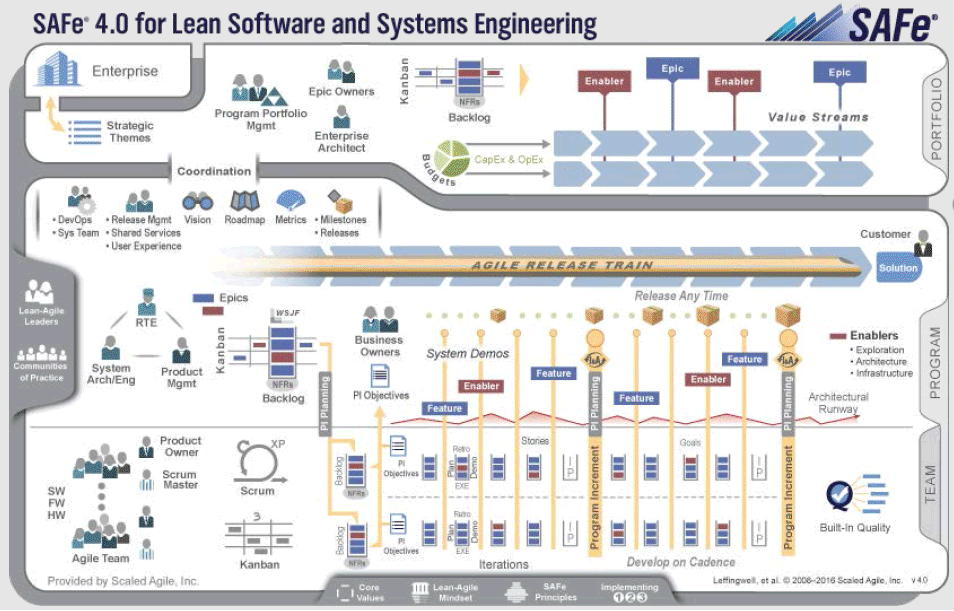
As you see in the above figure, SAFe is introduced as 'Scaled Agile Framework for Lean Software and Systems Engineering'. It shows that 'Lean' is one of the basic philosophies constructing SAFe. So I would like to insert a brief note on Lean here. Philosophy of Lean is often expressed in the form of 'House of Lean' (see the figure (right), borrowed from the SAFe White Paper). The goals of the whole activities/organizations are making (or adding) 'Value', especially in the sustainably shortest lead time. For obtaining the results successfully, we need to have four pillars of supporting activities. They are: Respect for people and culture, Flow (or adapting for changes), Innovation, and Relentless improvement. And as the basis of them all, 'Leadership' (at different levels) is necessary. Thus 'Innovation' (as well as Improvements) is regarded as one of the most important aspects in SAFe.
So far is the preparation for understanding the background knowledge of software development method, particularly SAFe (Scaled Agile Framework). We now come to the position to learn Author's original work, i.e., trying to integrate TRIZ into SAFe for the purpose of enhancing the innovative power in the leading-edge methodology of software development.
In the slide (right), the Author views the roles of SAFe and TRIZ from the viewpoint of approaches to innovation.
SAFe provides the opportunities, fields, and financial support for innovation. Producers (or software/system developers) innovate values and customers validate them. Trying to turn the value creation & validation cycles quickly is the Lean as well as Agile approaches. On the other hand TRIZ provides various basic concepts and thinking ways for achieving innovation.
Thus the Author hopes to introduce TRIZ into SAFe, so as to create a focus on more breakthrough innovation, address key problems in existing SAFe practice, and enhance the existing SAFe approach.
The Author discusses the three levels of SAFe one by one. For each level, he describes the key activities of SAFe, and lists up opportunities of TRIZ contribution with brief illustration of a few examples. He explains the three levels from top to bottom. However, explanation in the bottom-up manner, as in the SAFe White paper, seems easier to understand. So the Authors slides are rearranged below in the order: Team Level --> Program Level --> Portfolio Level.
The lowest level in SAFe is the Team Level (see slide (right)). The basic activities of developing software are carried out by Teams, just as in the Agile software development (see the description above in (b)). SAFe gives the guidance on how Agile teams should work.
The SAFe Agile Team is a cross-functional group of individuals (5 - 9 members) who have the ability and authority to define, build, and test Solution value - with the iteration of short term (i.e., Sprint; say for 30 days). Thus the key activities at Team Level are planning, solution design, problem solving, and coordination inside the team.
Opportunities of using TRIZ at the Team level are similar to cases in ordinary jobs. In planning and designing solutions (to be developed as software), tools like 9-windows method are useful for changing/broadening perspectives and for obtaining solutions in general (i.e., not limited to software) scope. Ideality is also useful for getting out of firefighting from holistic perspective.
The middle level of SAFe is Program Level (see slide (right)). SAFe gives guidance at this level on how planning, coordination and integration should be done across teams.
At this level, a virtual organization, called 'Agile Release Train (ART)', is formed as a long-lived, self-organizing team of Agile Teams (usually 5-12 Teams, 50 - 125 participants). Managers, experts (e.g., system architects/engineers, quality engineers, etc.), business owners (or customers), etc. support the ART. Along a value stream of the enterprise, ART carries out the jobs for planning, designing, building, testing a whole system of software.
Most important activity is to design the solution (to be developed as a system of software) by splitting epics (or stories of solution) into features (or functions to be implemented as software) and build up and maintain the Program Backlog (or to do list). The ART coordinates the Teams to do their Sprint jobs in cadence and synchronized way.
In addition to the (ART-)internal system demos at the end of each Sprint, the whole system developed so far are delivered to customers/users every 2-3 months in the form of 'Program Increments'. Thus the events for initializing a new Program Increments and for reviewing the work of the finished Program Increments are important for all the members of the ART. A 2-day workshop for Program Increment Planning is held with a standardized agenda as shown in the slide (below). The Author explains the significance of this planning workshop in the slide and thinks it a good opportunity to introduce some concepts/tools of TRIZ.
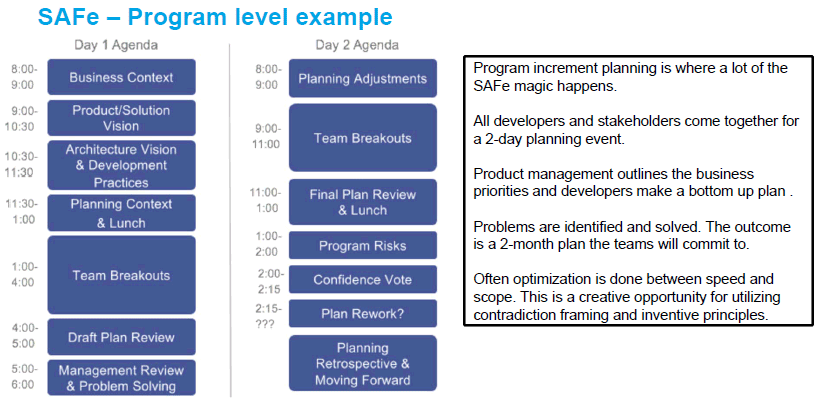
The slide (right) discusses about the top level, i.e., Portfolio Level. This is the crucial level for the enterprise, because it decides what to do. SAFe gives a guide at this level on selection and analyses of initiatives, setting high level goals, linking strategy to development work, and program level funding decisions.
At this level, the enterprise or its business unit should decide what to do for achieving its mission. For such a decision, the enterprise has to set up their mission and visions, and think over their business domains, themes, strengths, etc. while understanding the situations and directions of society and economics, etc.
The Author writes the key activities at the portfolio level in the slide (right). Epics (or stories) here means the concept level solutions which is decided to develop into a software system. They should be aligned to the company's strategy and should be creative and well defined. The development need to be organized and funded at this level.
TRIZ can be used at the Portfolio Level also, the Author writes. Ideality, contradictions, 9-windows, etc. are listed as possible effective tools (see slide (above right)).
In the slide (right), the Author illustrates an example of usage of Contradiction in considering the big theme at the Portfolio Level. The scheme of representing a contradiction here has a partial origin in the Theory of Constraints (TOC) and has been used actively by Darrell Mann. It can represent Technical Contradiction and Physical Contradiction at the same time, and hence can guide to suggestions of various Separation Principles and Inventive Principles in TRIZ.
The Author concludes his presentation with the slide (right), summarizing that SAFe and TRIZ are complementary with each other.
SAFe (Scaled Agile Framework) is quickly becoming an enterprise standard in the field of software/system development. It has strong features of fast feedback, customer validation, and 'Gemba', but lacks in supporting ideation. TRIZ offers proven tools for ideation, in various problem situations. Ideality, contradictions, inventive principles, etc. are such tools. So introducing TRIZ into SAFe is expected to be very fruitful.
*** I learned much with this presentation. I worked in the field of software engineering in 1980s, studying the Waterfall Model, Rapid prototyping, object-oriented programming, etc. In 1990s when we met TRIZ (in Japan and in the Western countries), people working in software development refused to accept TRIZ saying "TRIZ comes from 'hard' engineering, hence not applicable in software development". It took many years for TRIZ to get into the software field. Two books appeared: "Systematic (Software) Innovation" by Darrell Mann (2008) and "TRIZ Principles for Information Technology" by Umakant Mishra
(2007, Japanese Edition 2014). But they seem not widely read.
Meanwhile, Agile software development method and its extended version SAFe seem to have been revolving the software industry. I hope we can introduce TRIZ into the new-generation of software development. The situations are very similar in hardware and software technology fields. In the manufacturing (and other) industries we are trying to integrate TRIZ into Lean (and similar methods) for project management in the 'Real World'. Similarly in the software development industry we try to integrate TRIZ into the project management methods (such as Lean-Agile method (SAFe)) in the 'Real World'.
I wish the present Author apply TRIZ to SAFe activities and make many cases of success. We may need to have several TRIZ tools effectively adapted for some types of problems in the SAFe activities.
G2. TRIZ potential for IT projects
Monika Woźniak (Univ. of Gdansk, Poland)
I will quote the Abstract written by the Author:
The article has been inspired by over a decade of the author’s studies concerning the reasons for failures of IT projects. The studies were based on both the author’s own research projects and a systematic review of reports and literature on the topic. As the success rate of IT projects and of the use of IT system functionalities within organizations is rather low, it appears worthwhile to undertake a multifaceted search for the causes of this phenomenon and for the opportunities to improve the situation.
Being a method of systematic problem solving correlated with innovation, TRIZ addresses both these issues. The present article discusses the arguments for the implementation of TRIZ in IT projects and the benefits thereof. Moreover, it presents the IT TRIZ solution as an opportunity to enhance the effectiveness of IT projects – the IT project implementation path with inherent modifications of business processes and the TRIZ-supported creation of an IT system for seamless operations of the organization.
In the slide (below left), the Author summarizes recent reports by international surveying companies on the situations of IT industries. Only about 35 % of IT project implementations are fully successful. The slide (below right) is a summary of Author's own research of the problem situations of IT projects. It describes that the mutual perceptions among three parties involved in IT projects (i.e., IT Project Manager, IT team, and Client) are miserably negative.
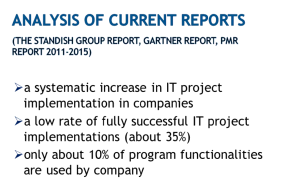
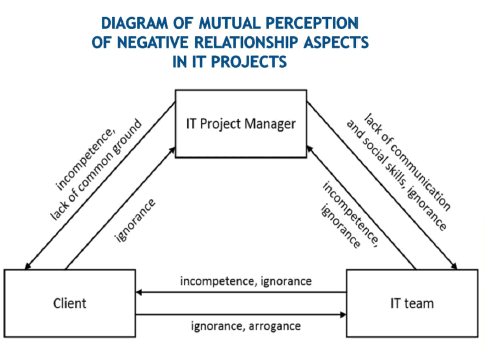
The Author shows her research theme in the slide (below left). How to improve the communication patterns among the stakeholders is set as the main theme. And she wants to find some solutions of common metalanguage of IT project communication, which can be understood by clients and IT managers as well as IT development teams. The Author suggests the possibility of TRIZ's basic concepts as a part of such common metalanguage. As shown in the slide (below right), she lists up 3 possible benefits from TRIZ. They are the concepts of contradictions, modelling of problems, and project management.
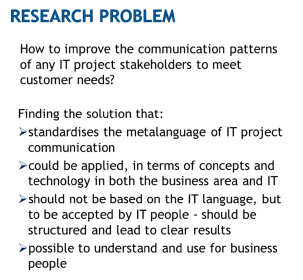
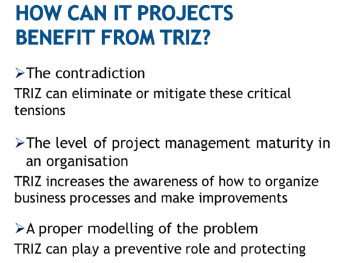
Along such a direction, the Author suggests two ideas of solution visions:
The first idea is shown in the slide (right). It expects that the IT projects are first supported by TRIZ experts for better communication between IT people and Client's people, in order to develop efficient IT solutions that grow client's business. Then, when both IT people and Client's people are trained in TRIZ, the IT projects are expected to be carried out without TRIZ experts. Further, Client's people who are trained in TRIZ would change business processes and IT projects would be carried out smoothly.
The slide (right) shows the Author's second idea. In this idea, Client's business processes and its IT systems are assumed to be reviewed/analyzed with TRIZ. If the business processes are found to be OK with the TRIZ analysis, the business processes may be mapped onto IT system. Then check the IT system with TRIZ, and if consequential problems are found, the IT system should be improved with TRIZ tools. If, at the initial check with TRIZ, the business processes are found to require a change, the business process should be changed with TRIZ tools. (... Much more steps are shown in the slide, but I will not mention them.)
*** This paper describes the current situations of IT projects in a very pessimistic tone while the ideas of improving the IT projects in a quite optimistic manner. I feel that (in the Author's first idea) TRIZ experts (or TRIZ methodology as a whole) do not have enough capability of coordinating IT people and Client's people and that (in the Author's second idea) TRIZ is not capable enough to judge (or analyze & decide) and dictate the business processes. TRIZ methodology (and TRIZ experts) can contribute to some parts of the two cases, but not to the full extent in any of the two cases.
The basic confusion of the present paper stems from the ambiguity of the positioning of the TRIZ methodology. For clarifying the situation, I would like to quote my figure (below) which I showed at my Introduction to Michal Halas' Paper (B3)
. I explain the Creative Problem Solving in general by using the Six-Box Scheme, where the problems are found and the solutions are implemented in the 'Real World' while the problems are analyzed and conceptual solutions are derived in the 'Thinking World'.
Representing in the Six-Box Scheme, TRIZ is essentially the methodology in the 'Thinking World' and is weak in the 'Real World'. On the other hand, 'Project Management' concerns mostly the activities in the 'Real World'. Thus the Project Management of IT projects should not be handled directly with TRIZ. When various problems are found in IT projects (in the 'Real World') and brought in to the 'Thinking World', TRIZ methodology/tools can be applied to solve them individually (or depending on the types of problems). Management of IT projects should be handled mostly as the activities in the 'Real World'; the Lean-Agile software development (or SAFe (Scaled Agile Framework) in the previous paper G1
) is a nice example of such project management methods. Since SAFe is still weak in the methods in the 'Thinking World', it is expected to be enhanced by the introduction of TRIZ. Similarly, various methods which have been developed and used in different application areas (in the 'Real World') are often weak in the 'Thinking World' and hence can be enhanced with TRIZ.
G3. Developing Growth Portfolio with TRIZ Structures
Michael Ohler, Philip Samuel, Naresh Shahani, Derek Bennington, Riaan Britts (BMGI, Germany & USA) ![]()
The Abstract by the Authors is as follows:
Creative destruction is taking its toll on corporations. We live in an era where the rate of change for change itself is accelerating and the half-life of new innovations is growing shorter, demanding the ability to innovate time and time again at a faster pace. Globalization, changes in market trends, customer demands, and regulations and lower barriers of entry are causes of this acceleration. Companies must find new forms of differentiation by creating new products, services, processes and business models in order to earn their place in the market every day by becoming more agile, more innovative, and more adaptable. Developing a new portfolio of solutions that meets or beats expectations in the marketplace isn’t an easy feat, and it’s even more difficult to do on a sustainable basis. To ensure success, the first step is identifying a new portfolio of opportunities.
This paper discusses how TRIZ thinking can enable the identification and development of growth portfolios for innovations when used in tandem with Market Trends, Customer Insights and Technology Trends. The roadmap is the result of several years of portfolio identification projects carried out within a number of companies from a variety of industries. With the help of examples and case studies, we discuss the lessons learned, as well as best practices when integrating TRIZ with other strategy tools to develop a robust innovation portfolio.
In the presentation, the Authors first posed a question to the audience, as shown in the slide (below left). The Authors borrowed this story from a LinkedIn article by H.H. Merlegrace O'Brien (South Africa, Jan. 2016)
, which starts as:
"What if an internet-enabled fridge at home automatically placed an order with the grocery store of your most commonly used items? And the financial transaction is processed by your telecom provider? And the goods are delivered directly to your doorstep via a drone within 30 minutes of placing the order?
A year ago, this could have been a movie scene but in January 2016 it became reality as MasterCard launched its Grocery App pre-loaded in a Samsung Family Hub Refrigerator. ... "
M. O'Brien explains this innovative change in terms of interactions of 6 (macro) trends of society and technology, as shown in the figure (below right). The trends cited here are Predictive personalization, The Internet of Things, The rise of drones, Instant gratification, The confluence of economics, and Loyalty schemes.
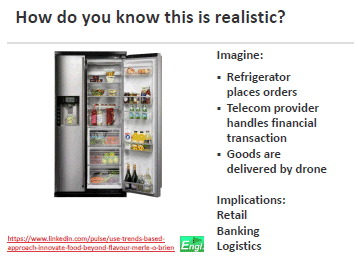
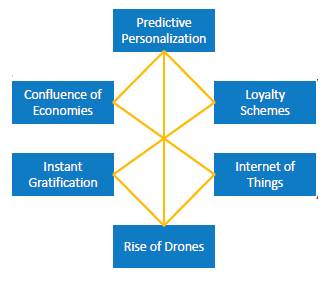
After the introductory talk, the Authors introduce their perspectives, as written in the first paragraph of their Abstract. "Companies must become more agile, more innovative, and more adaptable." For this purpose the Authors discuss about the methodology for developing new portfolio solutions. Their whole framework is represented in the slide (right), as the life cycle of products, processes, and business models. We may read this life-cycle model starting at the green boxes. Daily management and (relentless) Improvement are the activities being carried out in many different aspects and phases as businesses . Then from time to time, we find ourselves necessary to reflect our ways of business (of our products, processes, and business models, etc.) in the rapidly changing environment and to find what to do and to implement the solutions (in the four blue boxes in the slide). 'Opportunity Exploration' is the phase when we should explore the full range of possible opportunities of our new products, processes, and business models, etc. and to set the strategic directions for innovation. 'Front End of Innovation' is the phase when we should find ideas and obtain finally an innovation solution. The Authors advises to carry out Rapid Innovation Cycles by using D4 process (i.e., Define the opportunity, Discover ideas, Develop solutions and Demonstrate the feasibility), where generating conceptual ideas, quantitative assessments of designs, and qualitative user experience testing are done in multiple rounds. 'Back End of Design' is the phase when we take such a solution and develope and perfect the design of the innovation solution. The Authors advises to use 'Design for X' process, typically managed through a phase-gated approach. 'Commercialization/Operationalization' is the phase when the solution is delivered to the market for external customers or fully operationalized for internal customers. Change management, stakeholder communication, and revisions based on customer feedback are essential.
The present paper aims at visualizing the methods (especially based on TRIZ) for the 'Opportunity Exploration' phase, even though TRIZ can be used much more in the 'Front End of Innovation' phase.
The output of the 'Opportunity Exploration' is an Innovation project portfolio' (see the slide (above)). It can not (or should not) be a proposal of a single project of an innovative product (or process or business model). The slide (right) shows this point more clearly. An Innovation project portfolio must be balanced with respect to types of innovation and to degrees of innovation (just like the company's portfolio). Innovation of products/services should go together with innovation of processes and innovation of business models, the table says. At the same time, the degrees of innovation must be balanced in Radical, Substantial, and Incremental innovations. Such balance in the two aspects must be selected according to the company's strategy, considering the effectiveness, feasibility, sustainability, etc. in the changing environment. "Directly align innovation efforts to your organization's strategy", the Authors write.
For developing the Innovation Portfolio in the 'Opportunity Exploration' phase, the Authors discuss three methodical approaches: (A) Market Trends, (B) Customer Insights, and (C) Technology Trends.
In the approach of (A) Market Trends, first identify the mega, macro, and micro market trends impacting the customer segments. For example, 'Digitization' is a mega trend, while 'Internet of things' a macro trend and 'Biometric payment' a micro trend. (*** Such mega/macro/mini trends are best accumulated in the book "trenDNA: Understanding Populations Better Than They Understand Themselves" by Darrell Mann and Yetka Ozozer (2009).) Selecting (10 to 20) most important trends, represent them in the Trend Relevance Map to show their implications and mutual relationships. (*** A sample figure is in the paper but missing in the presentation slides.) Such a map guides us to think of the implications for future in terms of scenarios. And such scenarios often contain conflicts (or contradictions) among the trends. An example of such a contradiction is shown in the slide (right), using the scheme originated in TOC and adopted by Darrell Mann in TRIZ. In the slide (right) the title says 'Contradictions due to uneven development of sub-systems' but we may understand it as 'contradictions between future trends', because we are now talking about the whole market and whole society as the system.
In the approach of (B) Customer Insight, first identify the jobs customers are trying to get done (or Jobs-To-Be-Done) and categorize them in terms of under-served, served-right, and over-served. For this categorization consider the Jobs-To-Be-Done in a 2-dimensional space, where x-axis stands for the importance for the customers while y-axis the user satisfaction. (*** A sample figure is in the paper but missing in the presentation slides.) In this context, TRIZ will help giving the concepts of ideality (for scaling the customer satisfaction) and also suggesting the resources available or needed to get the job done. Such consideration, based on internal perspectives and eternal customers inputs, will guide us to prioritize and select the most important product/service/process/business model innovations to pursue, the Authors write.
For the approach in (C) Technology Trends, TRIZ can provide rich and effective concepts and tools.
The Slide (right) shows a method based on the analysis of IPs (Intellectual properties) of our own and competing companies. By scanning the IP databases, we find IPs in the relevant fields. Then knowing the market trends, we will be able to evaluate the value of each IP at the present and in future, e.g. in 10 years. Plot of the IPs in the two-dimensional space, i.e., Current value index vs Future value index, contains various implications. We can read the graph (such as the one in the slide (right)), to learn what are the most important patents in the future, to think of possible ways of the IP portfolio especially against the competing companies, etc.
Slide (right) shows a diagram of 'Patent Landscape Analysis'. The Y-axis shows a list of patent categories, such as IPC. The columns are taken to show the companies. Blue circles show the number of patents in the specific category of the specified company. This diagram clearly shows the overview of each company's IP strategy, The white spaces suggest possible nitch application areas.
Another useful method is the Evolutionary Potential Radar Chart, as schematically shown in the slide (right). This is based on the TRIZ findings of 'Laws (or Trends) of technical evolution'. In various aspects (e.g., increased dynamization of within the system), technical systems are understood to evolve to known direction towards the increase in ideality. The radar chart is arranged to have spokes of different aspects and the stages of technical evolution of each aspect are scaled on the spokes outward for the increased ideality. Individual product/process (or patent of such) may be analyzed with respect to these aspects and plotted as shown by the brown pattern in the slide (right). The pattern reveals that the product/process is much advanced in some aspects while not well advanced in some other aspects. Knowing the evolution steps of all the aspects, we may assume the evolution goals of for each aspect. The difference from the current stage to the goal is called the 'Evolutionary Potential' for each aspect. Thus as shown in the blue ranges in the slide (right), we can understand the Evolutionary Potential of the product/process. This gives us guidelines to put efforts for innovation. Particularly, comparison of products/processes of different (and competing) types or different companies may be suggestive for deciding the opportunities of innovation.
The slide (right) shows the 'Sun Diagram' approach for comparing different technologies aiming at performing the same function. Since those technologies have the same goals of achieving a function, they can be represented to pursue the same ideal system, in the sense of TRIZ. Different technologies, however, do have different problems, some of which have been solved already and some others have to be overcome from now on. The problems known (or foreseen) may be expressed in terms of a series of technical contradictions in TRIZ. Thus, as shown in the slide (right), competing technologies may be expressed as different passes climbing up to the same mountain top, i.e., Ideal system. If we can evaluate the difficulties of solving the series of problems for each technology (or technological approach), we may express the relative positions (i.e., height of climbing) of the technologies. Thus the circular line express equivalent positions of difficulty (or height to reach the top) and the small circles represent the present positions of competing technologies. This method was developed by Denis Cavallucci et al.
The Authors show the slide (right) as a typical process for conducting the Opportunity Exploration. In summary, The Authors write: "by (A) focusing on relevant market trends, (B) gaining insights about customer needs, and (C) company’s technology maturity, organizations can converge on a strategy for their innovation opportunities."
The slide (right) is the lessons for TRIZ practitioners given as the conclusion of the presentation.
(*** This paper is nice as an introductory review on how to apply TRIZ-based methods to 'Opportunity Exploration' at the initial phase of developing 'Innovation Portfolio'. The individual TRIZ-based methods introduced here are cited from various papers by other people in reference.)
G4. Structured activation of vertex entropy (SAVE): another way around creative problem solving for non-technical applications
Stelian Brad (Technical Univ. of Cluj-Napoca, Romania) ![]()
This is an excellent paper of a simple and effective new approach to creative problem solving in non-technical areas. The Abstract by the Authors is as follows:
Beyond the indisputable value-added of TRIZ to creative problem solving (CPS), its application in non-technical cases generates difficulties for non-technical people. This paper proposes a tool for CPS related to non-technical applications, called Structured Activation of Vertex Entropy (SAVE). SAVE uses ten vectors for activating non-linear thinking, organized in a specific way to gradually provoke the mind for CPS.
In order to test its potential in practice, an empirical experiment was conducted. Three non-technical conflicting problems were given to three focus groups: one led by a TRIZ expert, one trained to use TRIZ contradiction matrix (CM) and supported by a software tool for TRIZ CM application on non-technical problems, and one that uses SAVE. Considering the first group as reference, results from the experiment have been compared and feedback on the experiences from the three focus groups have been collected. The empirical research revealed a good potential of SAVE for CPS and a proper acceptance by non-technical people.
The Author's philosophy is illustrate in the slide (right) and is written in the paper as follows;
"In order to investigate conflicting problems in a less abstract way, this paper introduces a technique called Structured Activation of Vertex Entropy, abbreviated as SAVE technique. Its purpose is to activate the system with respect to well defined external stimuli and see the feedback from the system. At every stimulus the system will react in a way and will obtain a certain “shape” (result). The idea is to start with a stimulus and continue with a series of stimuli in accordance with the analysis of the current state of the system such as to direct its evolution to the desired result. In this respect, before starting the application of any stimulus, the final result should be formulated. At every iteration, the gap is determined and another stimulus is applied. In theory, any stimulus and order of stimuli application can be experimented. In practice, a relative small amount of stimuli should be considered, as in the case of design of experiments."
(*** Interestingly, the System is illustrated with a heart mark representing the mindset of the problem solver.)
The slide (right) the Author's comment on the role of the 'Stimuli' (as mentioned above). The Stimuli challenge the mind of people to think of some ideas in front of different constraints, by means of unblocking their own mind.
Then the Author introduces the 'Stimuli' in the words of 'Vertexes' as follows:
"Empirical researches during several years, on different projects run with students, led to the selection of ten SAVE vertexes (or stimuli). They have been primarily extracted from real life examples, considering that such situations convince audience and represent very good models to be followed by usual people. These vertexes are further introduced."
10 Vertexes are explained in the following slides (below):
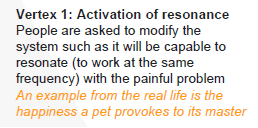
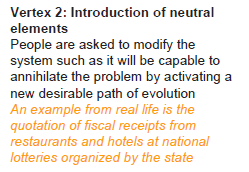
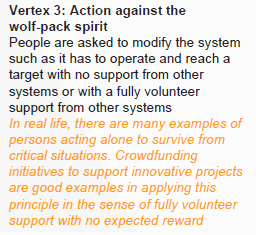
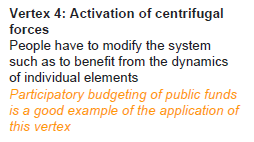
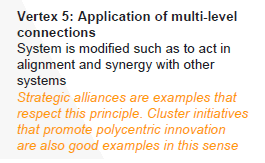

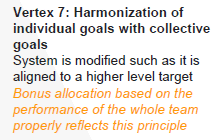
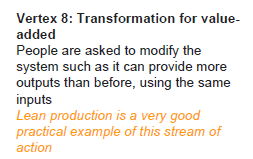
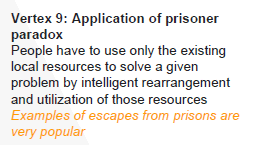
Then the paper (and the slides) describes an experiment of comparing the effects of SAVE technique and TRIZ conducted by 3 groups of people for 3 typical real problems. 3 groups of executives (of 5 members each) wee formed to solve problems by use of different methods (see slide (below left)). Every group were requested to solve the 3 Exercise problems, typical ones in non-technical business areas, as shown in the slide (below right).

The Author describes the processes and results of exercises of each problem/group in detail in the paper and relatively briefly in the slides.
The slide (right) shows the results of Group 1. Prior to the exercises, this group was trained for 2 days on the TRIZ Contradiction Matrix (CM) using business-oriented CM software. During the exercises, the 5 executive members tried to solve together by using the CM software. However, they met much difficulties, resulting in non-innovative solution ideas.
The slide (below) shows the results of exercises done by Group 2. This group is 'guided' by a TRIZ expert. Though not shown explicitly in the slide(s), the group used the TRIZ Contradiction Matrix (with the software as well, I guess) as described in detail in the paper. Thus, though not stated in the slides and in the paper, this group also received the TRIZ CM training (probably for 2 days), I suppose. Group 2 have applied the TRIZ CM method in a more appropriate manner to obtain some interesting ideas as shown in the slide (below).
The results obtained by Group 3 are described in detail in the slides for each of the 3 exercises. Here I will show the case of Exercise 3 (slide (below)). The Group 3 received the training of SAVE technique for 2 hours. (I suppose the Group was 'guided' by a 'SAVE expert', i.e., the Author.) At the start of the problem solving with SAVE, the target result is stated first, and then 'the system at present' is confirmed. Then Vertex 1 is shown to the group for discussion and the ideas obtained at this stage is recorded as shown in the slide. Then Vertex 2 is shown, and the idea is improved slightly. In this manner, Vertex 3 and Vertex 4 are presented for obtaining improved ideas. At this stage, the Group decided the idea obtained is good enough for the solution.
The following 3 slides (below) are the lessons learned from these exercises, especially respect with the SAVE technique.
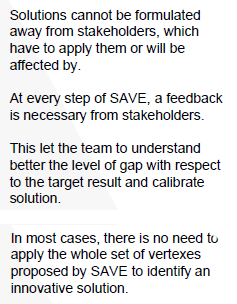
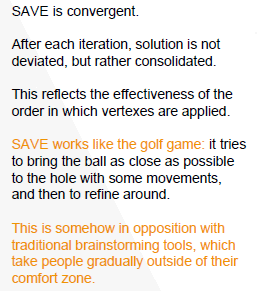
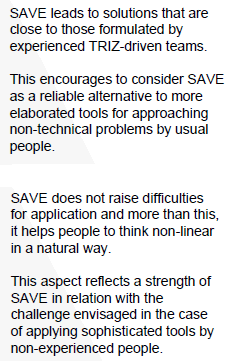
The Author concludes as shown in the slide (right).
*** I fully agree with the Author in his conclusions. The Vertexes are (intently) quite vague to stimulate the people's mind open. Accumulation of examples (or implications of Vertexes) will make the method more effective, I hope.
G5. TRIZ to support creation of innovative shared value business initiatives
Stelian Brad (Technical Univ. of Cluj-Napoca, Romania) ![]()
The Abstract by the Authors is as follows:
Shared value companies and business initiatives focus on creation economic value by creating social value. Solving major social problems in a profitable way is a challenge, as long as shared value businesses envisage both societal progress and faster and more sustainable growth. The topic is very new in the literature and there is a lack of methodological constructs for approaching creation of shared value business initiatives in a structured way.
The purpose of this article is to employ a TRIZ-driven framework for defining innovative shared value business initiatives. The methodology investigates the contradictions in the shared value concept and reveals generic areas of intervention. Vectors for disrupting status-quo are used to explore the areas of intervention for business idea formulation. Results are analyzed from various perspectives (positive, negative, objective, etc.) to feed business idea with content. The process ends with reconsideration of TRIZ to tackle those issues that still require conflict solving. Two examples from IT industry reveal the potential of the methodology to support the formulation of reliable shared value business initiatives.
In the first part of the paper, the Author develops the methodology of Creating Shared Values. Shared value is defined by Porter and Kramer (2011), as cited in the slide (right). The Author explains in a much shorter form: Shared Value is "searching for profitable business opportunities in social problems" (see slide (right)).
[*** The slides shown in this Introduction rearrange the Author's slides for better readability (by adjusting the font sizes, eliminating decorative designs, etc.) while reflecting the texts faithfully.]
The Author formulated the challenges for achieving Shared Value, as shown in the slide (right) in general terms.
Then the Author expressed these challenges in the representation of Contradiction Matrix (CM) in TRIZ (slide (below left)). Numbers in ( ) stand for the CM parameters.
Using TRIZ CM for business & management, multiple Inventive Principles (in TRIZ) are suggested as generalized solutions to each contradiction. Then, a list of frequently suggested Inventive Principles are obtained as shown in the slide (below right). Such Inventive Principles are called 'Areas of Investigation (AI)' for achieving Shared Value.
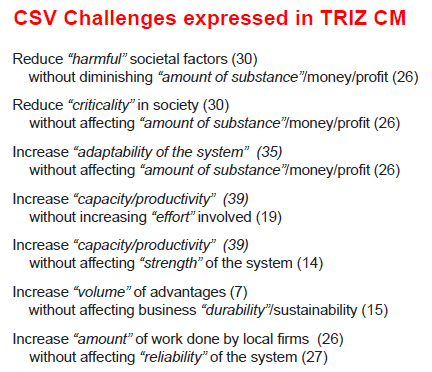
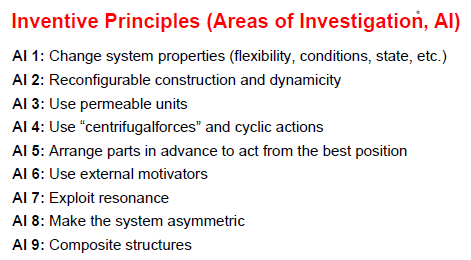
On the basis of the understanding of the Shared Value problems in general, a new process for pursuing specific Shared Value has been developed by the Author, as shown in the slide (right).
The first step is to find/observe Societal problems with the approach of "Go-to-Gemba", Then, prepare a table of AI (Areas of Investigation) × CP (Company's Portfolio) and assign the Societal problems to relevant places in the AI-CP table.
Then in Step 4, various aspects of Societal problems allocated in the AI-CP table need to be solved. For this ideation step, the Author uses the 'Disrupting Vectors', shown in the slide (below right). They are called 'Vertexes' in the Author's preceding paper (G4). So the Author actually suggests to solve smaller parts of the Societal Problem quickly with the SAVE technique (G4 ).
Step 5 is the Feasibility analysis. A detailed checklist is prepared, as shown in the 2 slides (below). Its usage is briefly shown later in the case study.
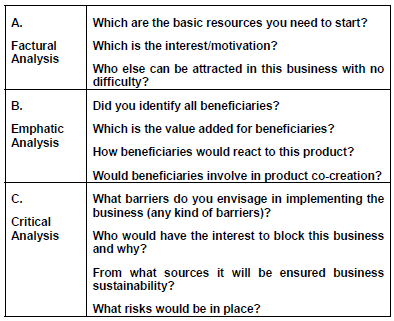
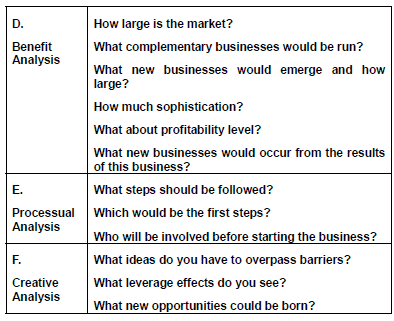
In the latter half of the presentation, the Author demonstrates a case study. The Author actually worked with an IT company in his city in Romania for designing this business model. (In the paper the Author describes another case study.)
This Case Study has tried to achieve Shared Value in the Agro-food sector in the Region of Balkans and Black Sea. (slide (right)).
The slide (right) is the description of the Societal Problem, i.e., Step 1.
The problem is related to unfair practices of the retailers in the public agro-food markets and supermarkets. Small local farmers have to sell their products at very low prices to the intermediaries, who control retail markets and obtain high margins. Consumers are forced to buy poor quality products at high prices.
In this case, an IT company is trying to build an IT-based retail system. Thus in Step 2, the company's current product portfolio (CP) is shown in the slide (below left). Using the standard 9 AI (Areas of Investigation), a (blank) AI-CP table is prepared as in the slide (below right).
Then in Step 3, we understand we have two social problems (SP). SP1 is 'no reliable retail channels'. So we check all the cells of the AI-CP table whether the problem SP1 is related. Web applications (P1) need to be investigated on this problem (SP1) at the areas of AI1 (Change system properties), AI5 (Arrange parts in advance to act from the best position), AI7 (Exploit resonance), and AI9 (Composite structure); such information is inserted in the AI-CP table. Similarly SP1 is checked for other Portfolio P2 (database systems), P3 (Process management systems) and P4 (Financial management). The second problem SP2 is 'Poor quality/unhealthy products at high prices', and is also checked for all the cells in the table. (Slide (below right))
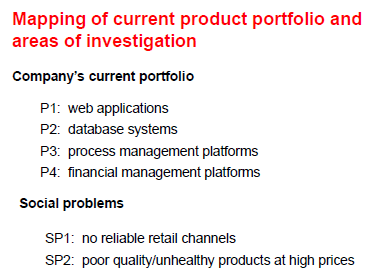
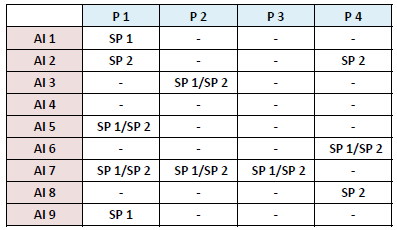
Step 4 is to obtain solution ideas for individual subproblems listed in the slide (above right). For example, the cell AI1-P1 applied on SP1 suggests the development of a web platform for small farmers where they can introduce information about their products. In this case, AI1 'change conditions' was interpreted as a new environment where farmers can promote their offers. The cell AI2 - P2 applied on SP2 suggests the development of a mobile app where consumers can introduce and find information about prices of various products in different places, thus generation an indirect pressure for price regulation. In this case, the vector AI2 'reconfigurable construction and dynamicity' was the source of inspiration for the mobile app where consumers can be contributors themselves. All other sub problems were considered for ideation, the Author says.
For enhancing the area of search fro new products, the 10 Disruptive Vectors have been applied to the two major problems SP1 and SP2.
"The application of 'activate resonance' led to the idea of putting in direct contact small farmers and consumers from the urban areas using a web platform/mobile app, thus removing retail intermediaries. Of course, this idea must be further elaborated to reveal the whole value chain of the new business. Applying to this idea the disrupting vector 'introduce neutral elements', the concept is enriched with the idea of including a quality certification body in the ecosystem, for issuing quality certificates, as well as online feedback of beneficiaries. Continuing the reasoning and adding the vector 'act against the wolf-pack spirit', the solution was enhanced with the idea of allowing any producer to use the platform for free up to a certain level of trade, and then allowing to purchase customized vouchers. The vector 'use centrifugal forces' suggested the opportunity to upload additional information for product traceability over its life time. ..."Combining all ideas, the Author obtained the vision of the new business looks like: “An agro-stock market using a web and mobile software system that puts in direct contact small farmers and urban consumers for direct procurement of goods, with online support, with possibility for just-in-time door-to-door delivery using a smart distribution and storing network, as well as with feedback loops for quality guarantees and highly competitive prices”.
Next in Step 5, the vision of the model has been checked further against the feasibility checklist. The Author shows the Question-Solution pairs of all the 23 questions. Here a part of them is shown for the category of C. Critical Analysis (slide (right)). In this case study, the challenge is how to activate both producers and consumers to make deals using the dedicated web platform. Particularly, small farmers have poor skills to use web platforms and are reluctant to use it because they do not understand the system and the business model behind. TRIZ CM is used again to generate various specific solutions. For example, introduce a network of partners (NGOs, volunteering associations, other social initiatives, etc.) responsible for promoting the platform among producers and work close with communities of producers to learn them how to use the platform and support them. Similarly, introduce a business unit responsible for activation of the platform among customers.
The present case study has already been implemented to some extent as a network of businesses. The Author demonstrates the slide (right) at the end of this case study report.
*** This is an excellent paper which has developed a methodology for building up a profitable business model while solving societal problems and has demonstrated a case study. We can learn a lot how to think and solve such a big/vague problem and to build a concrete vision. It is remarkable that TRIZ-way of thinking is used again and again at various stages and from different aspects.
G6. Conceptual framework for marketing communication management with a qualitative and system-oriented approach
Joanna Kijewska, Marek Goliński (Poznan Univ. of Tech., Poland)
The Abstract by the Authors is as follows:
The objectives of marketing, in analogy with other science disciplines, can be classified into two main categories. The first one, the cognitive objectives (such as theoretical, scientific, modelling), reflects the necessity to acquire and collect the complex knowledge about the marketing exchange relations between the market entities. The second one, the practical objectives (such as engineering, constructive, normative), reflects the quest for practical methods for the rational (i.e. efficient, aggregating effectiveness, agility, energy usage and economic issues) operational marketing activities. The broad marketing literature has proposed a large variety of theoretical concepts. On the other hand, practical methods and tools for the marketing have expanded dynamically. However, the theoretical background and the practical applications in the field of the marketing management are not really connected. Consequently, practical tools do not exploit the entire potential of theoretical studies and furthermore incoherencies may arise.
The aim of this paper is to relate the theoretical marketing concepts with the engineering procedures through the system thinking framework to face the problem of qualitative and systematic approach to marketing management. These assumptions are used in scientific research. Firstly, marketing is defined and the subsystem of marketing communication is selected for the further research. Secondly, the perspective for the systematic thinking concepts and methods application to the marketing communication management is considered. The qualitative operations and OTSM-TRIZ modelling is applied for the marketing communication research. Finally, the System Operator model of TRIZ thinking is adopted to combine the notions used in different systematic thinking theories and methods. The framework of the integrated marketing communication management with a system-oriented approach is proposed. The conducted research shows to have the potential of overcoming the two main difficulties of modern marketing, such as harmonic and systematic marketing management and the knowledge extraction from the marketing data.
The slide (right) illustrates the Authors' research approach. Concerning to the Marketing Communications, the Authors make both theoretical and engineering approaches (even though at the conceptual level at moment). First they make a theoretical model of Marketing Communication. Second, they clarify the Qualitology, i.e. science of quality, using the Entity-Attribute-Value concepts in OTSM-TRIZ, and thirdly they introduced the model of contradiction (in terms of OTSM-TRIZ). Finally, all these concepts are represented in an integral way in the System Operator model of TRIZ thinking, which is schematically shown as the two-dimensional boxes in the center of the slide (right).
The model of Marketing Communication is illustrated in the slide (below). The basic unit of the communication is a process: (Marketing) Information at a Sender is sent as a Message through a Channel of communication to a Receiver, who now owns the message as an information. Marketing communication is a complex collection of networks of such unit processes.
Quality of anything (or Entities, Elements of a system) can be conceptually expressed with a set of its Attributes (or Parameters). Quality of anything at a state can be expressed with a set of Values of the Parameters. Some of the Parameters may be under the control by the designer; they are called Active parameters (or Control parameters). Whereas other parameters reflect designer's choices on other parameters (of any (other) things); they are called Evaluation parameters. (These concepts are most clearly explained in the ENV (Entity-Name-Value) model of OTSM (i.e., General Theory of Powerful Thinking, developed by G. Altshuller and N. Khomenko). Using these terms, the concept of contradiction can be illustrated as shown in the figure (below).
The concepts defined so far in the present study are now represented in the System Operator model, as shown in the slide (right). System Operator is a generalized form of 9-windows method. In the vertical direction, Supersystem, System, and Subsystems, are arranged.. From left to right, the models of marketing communication are conceptually broken down. The descriptions at the Subsystem level may need some explanation. Subsystems of 'Marketing Communication' are Marketing Information, and sets of Sender, Channel (and Tools), and Receiver. When we discuss on the Quality (of the Marketing Communication), the latter sets (Sender, Channel and Tools, and Receiver) can be chosen by the designer, and hence their attributes are called 'Cause Attributes' (thus their parameters called 'Active Parameters'). Whereas the quality of the Marketing information reflects the (designer's) choices of other things (e.g., Sender, Channel and Tools, and Receiver), thus their attributes are classified as Effect attributes and their parameters as Evaluation parameters.
The present study has just built a conceptual framework for discussing the quality of Marketing Communication. Its application is the major tasks for the Authors' future research.
G7. TRIZ/CrePS approach to the social problems of poverty: 'Liberty vs. Love’ is found the Principal Contradiction of the Human Culture
Toru Nakagawa (Osaka Gakuin Univ., Japan; CrePS Institute, Japan) ![]()
This is my own paper. I put this at the last of introducing all the 50 papers presented at ETRIA TFC2016, because of its exceptionally big and unique areas of applying TRIZ. I wrote the Abstract as follows:
This is the first report of applying the TRIZ/CrePS methodology to real social problems. The problem of poverty among the elderly people in Japan is selected. I used “The Low-living Elderly (LLE)” book (T. Fujita, 2015) as the reference, and fully visualized its logic by use of the Fuda-Yose Tool (developed by A. Katahira). The book author explains that many LLE people are produced by the current social system and many more will be in future. However, in the customer reviews, many readers evaluate this best-seller book poorly, saying “For falling into LLE, the LLE people themselves are responsible, not the society”. Underneath these arguments I recognized the conflict of two social philosophies: “Win or Lose in the competitive world” on one side, and “Be kind and fair to all” on the other hand.
I formalized the observation in a hypothesis: Human Culture takes Liberty as the First Principle while Love as the Second. The two Principles however often conflict. ‘Liberty vs. Love’ is the Principal Contradiction inherent in the Human Culture. Humans have been trying to solve the Principal Contradiction. But the ‘Liberty vs. Love’ contradictions exist and newly appear everywhere, and getting even more difficult to solve. Revealing why and how they are made difficult to solve and investigating what are the ideal situations of coexisting of Liberty and Love are the important future tasks. The present study was guided by the CrePS process and the TRIZ philosophy of contradiction.
I will show here a selected set of my presentation slides, without trying to re-write introductions. The following two slides (below) explain why and how I started this work.
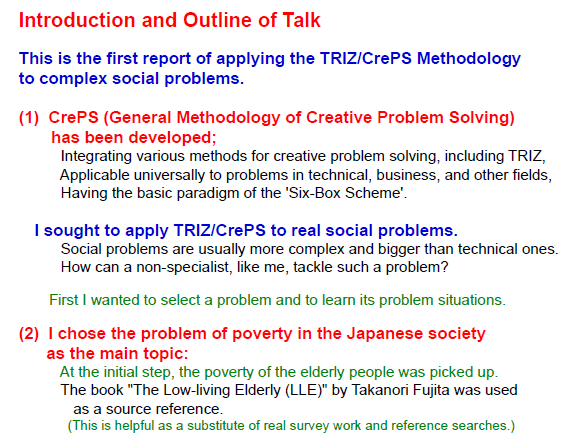

The slide (right) is an example of my diagram for visualizing the contents of Fujita's book. Fujita is alarming that "A large number of the Low-living Elderly (LLE) are recently produced in Japan. A severe risk is expected that most Japanese people would face miserable lives in their elderly days in near future."
The slide (right) describes the actual process of my thinking. Arguments accusing the self-responsibility of the low-living elderly exist widely among people, both rich and poor, and form a basis of social opinions of minimizing welfare under the slogan of 'Liberty'. On the other hand, many people realize that the poor, including LLE, are produced by the social system and that they should be saved by social welfare, under the slogan of Love. Thus social problems, such as 'poverty in Japanese society', have their deep roots in the conflict between Liberty and Love. I was guided this way by the TRIZ philosophy of 'To find root Contradictions for solving problems'.
As a result of thinking over the root contradictions, I obtained a big hypothesis as shown in the slide (right).
Principles of Human Culture can be written in a top-down manner as: (1) Liberty is the First Principle. (2) Love is the Second Principle.
However,(see the slide (below left)) (3) Liberty vs. Love forms the Principal Contradiction. (4) For motivating and coordinating both Liberty and Love, the Human Culture needs Ethics.
The basic structure of the Principal Contradiction (Liberty vs. Love) is illustrated in the slide (below right).
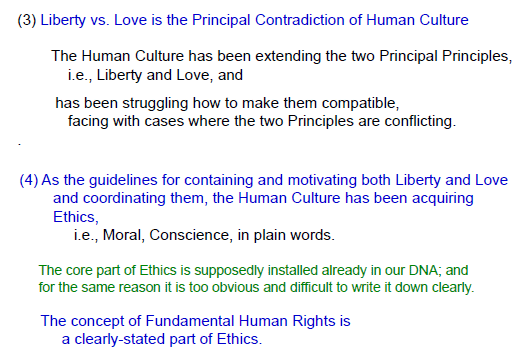
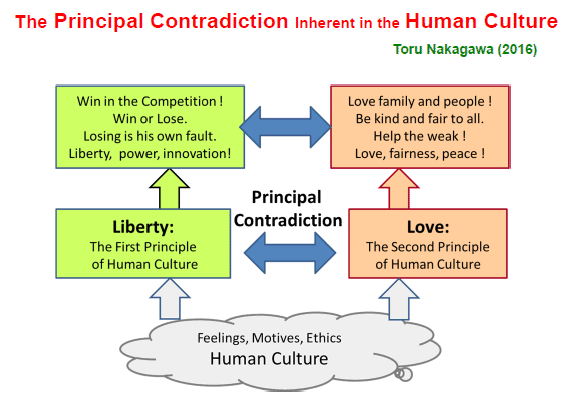
We know that Human Culture, through its very long history, has built various social systems and generated advanced culture. So have Humans solved (or found solutions) the Principal Contradiction, Liberty vs. Love? The answer is No. Cases of Principal Contradiction exist every where, emerge and grow everywhere, and become more and more difficult. See slide (right).
The Causes which make the Principal Contradiction even more difficult to solve are described in the slide (below left): (a) Desirable relationships among Liberty, Love, and Ethics are not clear at the personal level, (b) and at various social levels, (c) and can be turned over by individuals and organizations under the name of their Liberty, and (d) such turn-overs exist everywhere throughout the history.
Future task of study is focused on considering the actual and desirable relationships among Liberty, Love, and Ethics especially at the personal (and inter-personal) level. See slide (below right).
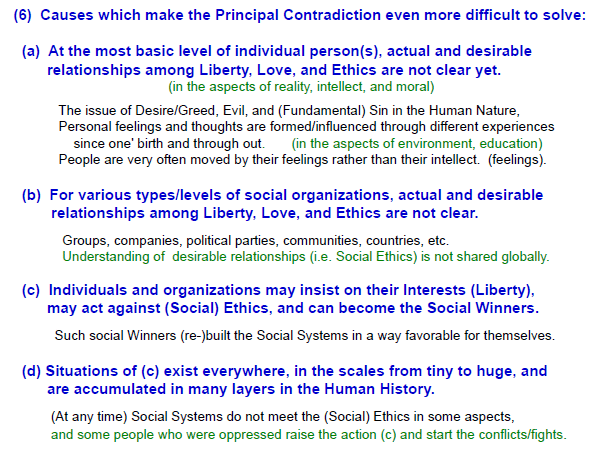
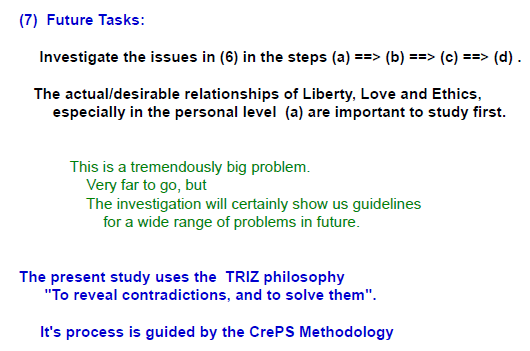
This study has been guided by the TRIZ philosophy and the CrePS Methodology, and has demonstrated their effectiveness in the application to big and complex social problems.
This paper has already been posted in this Web site "TRIZ Home Page in Japan". The full set of presentation slides are posted in the English page
both in HTML (images) and in PDF. Text of the paper is not allowed by ETRIA to post in this site, and will be accessible only with a link to the official publication probably in spring 2018.
Last updated on Jul. 18, 2017. Access point: Editor: nakagawa@ogu.ac.jp